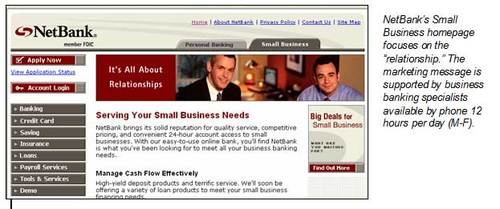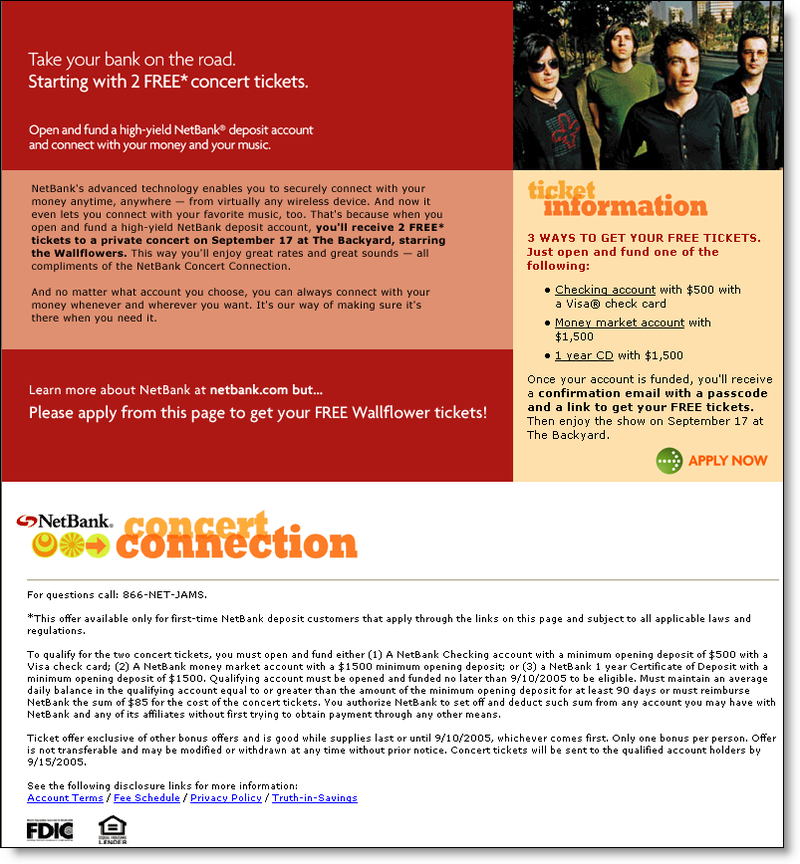Innovators in small business online delivery
|
Table 55
Watchfire/Gomez Small Business Scorecard
|
Rank |
Name |
Score
Dec ‘03 |
Number Sm. Biz Clients |
| 1 (tie) |
Bank of America |
7.6 |
2.5 mil1 |
| 1 (tie) |
National City |
7.6 |
ina |
| 3 (tie) |
Key |
6.9 |
ina |
| 3 (tie) |
Wells Fargo |
6.9 |
1.3 mil2 |
| 5 (tie) |
Chase |
6.8 |
300,0001 |
| 5 (tie) |
Fleet |
6.8 |
450,0002 |
| 5 (tie) |
Wachovia |
6.8 |
800,0001 |
| 8 |
Bank One |
6.6 |
ina |
| 9 (tie) |
HSBC America |
6.0 |
ina |
| 9 (tie) |
U.S. Bank |
6.0 |
ina |
Source: Watchfire, 6/04 <gomezpro.watchfire.com>
Other banks evaluated, but not making the top 10: Bank of New
York, BB&T, Citibank, Citizens Bank, Comerica, Fifth Third Bank
(150,000 clients), LaSalle, PNC Bank (200,000 clients),
SunTrust, UBOC, Washington Mutual (250,000 clients)
1American Banker, May 18, 2004, BofA total includes
FleetBoston
2American Banker, Oct. 1, 2003
|
Our first report on small business banking was produced in the fall of 1997
(OBR 29).
At that time, few banks were specifically targeting small businesses. Then,
a Yahoo search for “small business” and “banking” yielded only 19
results compared to 2.5 million today. In the late 1990s, most banks were
still busy building out their consumer interfaces. Even as recently as 2001
(OBR 70/71), we found few major innovations to report on. Our
favorite small business banking service was OneCore
http://www.onecore.com/ which was
shuttered shortly thereafter, at least as a direct provider.
Today much has changed. Everywhere you look, banks are innovating to
serve the small business market more effectively. According to
Watchfire’s GomezPro unit the best small business banking sites
are Bank of America and National City, tied for first place in
its year-end 2003 scorecard (see Table 55, right).
Other online innovators in the small business market:
- Barclays Bank (London; $800 billion) uses its
website to target startup businesses with a broad array of support
services that many startups would find essential, including a free
business checking account for the first year. It’s so impressive, we’ve
given it our second Best of the Web award this year
(see next page).
- PNC Bank (Pittsburgh, PA; $70 billion) and
NetBank have both announced plans to offer remote check deposits,
something most U.S. banks will support within a few years. One of the
last reasons to visit the branch will be eliminated when clients can
feed paper checks into a scanner instantly depositing the cash into
their account and storing the image into their online banking archive
This service is a shoo-in for an OBR Best of the Web once it goes
live.
- NetBank (Alpharetta, GA; $4.1 billion) which
launched a new small business initiative a year ago, has attracted 1,600
businesses with $38 million in deposits ($24,000 average deposit). If it
keeps to the announced third-quarter launch, NetBank may be the first
bank to offer remote paper check scanning
Barclays provides valuable services for startups
Why do the U.K. banks do a better job serving small businesses online
compared to their U.S. counterparts?1 Perhaps U.S. banks are
underestimating the value of services targeted directly to small business
owners. Or maybe they’ve found it too difficult because business owners
won’t bother switching bank accounts to save a few bucks a month. That’s why
it makes so much sense for Barclays Bank to focus on startups
at its business website <business.barclays.co.uk>. After all, if you
succeed in being a startup’s first bank, you have the inside track to retain
its business over time.
Barclays business homepage (see below) is dominated by a shaded
area asking the important question, Starting a business? Even though
the vast majority of visitors already have a business and a banking
relationship with Barclays, those most likely shopping for services are
startups. The bank also offers Pain relief in a box, a proprietary
business management and accounting program targeted for tiny businesses or
startups that haven’t settled on an accounting software system.
1Two out of three of our Best of Web winners for small
businesses are headquartered in the U.K.


Barclays’ small business Starter Accounts consist of the following
features and benefits:
- Current account (checking) with an overdraft facility; free
for the first 12 months, 18 if you also maintain personal accounts at
Barclays
- Savings account
- Loans, subject to credit approval of course
- Insurance
- 45-minute free consultation with a business/marketing
consultant
- 45-minute free consultation with an accountant
- 30-minute free consultation with an attorney
NetBank and PNC to offer remote deposits
According to recent press reports, both NetBank (American Banker,
May 20) with 1,600 small business clients and PNC Bank (Wall Street
Journal, June 8) with 200,000, will launch remote deposit service for their
business customers. Although details of the yet-to-be-launched services are
sketchy, it is expected that business customers will be able to scan paper
checks into a remote device that transmits images to the bank for immediate
deposit. PNC estimates the scanners will rent for $15 to $25 per month. No word
on pricing from NetBank. The NetBank service is expected in late third quarter
and PNC expects to roll-out by yearend. Alogent
http://www.alogent.com/ is the
technology provider for NetBank.
Benefits for small business owners:
1. Saves time/money: Frees business owners from the daily/weekly
trek to the branch, something 80% of online self-employed households reported
doing during the past 30 days according to Javelin Strategy
2. Improves cash flow: Checks can be deposited immediately rather
than collecting dust waiting for the owner’s next trip to the branch
3. Streamlines record keeping:
i. the original check can be filed as a paper receipt if desired
ii. a back-up electronic image is stored at the bank if questions arrive
4. Improves customer service: Check images can be quickly retrieved
and emailed if
a dispute arises
5. Saves storage space/cost: Paper checks can be destroyed much
sooner, eliminating storage and security issues
6. Improves management control: Owners can spot-check deposit
activity by looking at actual check images, rather than staff-entered accounting
entries
Speaking as both as a small business owner and an industry analyst, this is a
great service and a strong candidate for a Best of the Web award once it
becomes operational.

 In the early commercial Web era (1995 to 1998), five financial startups inspired me in terms of their innovative products and services:
In the early commercial Web era (1995 to 1998), five financial startups inspired me in terms of their innovative products and services: 






